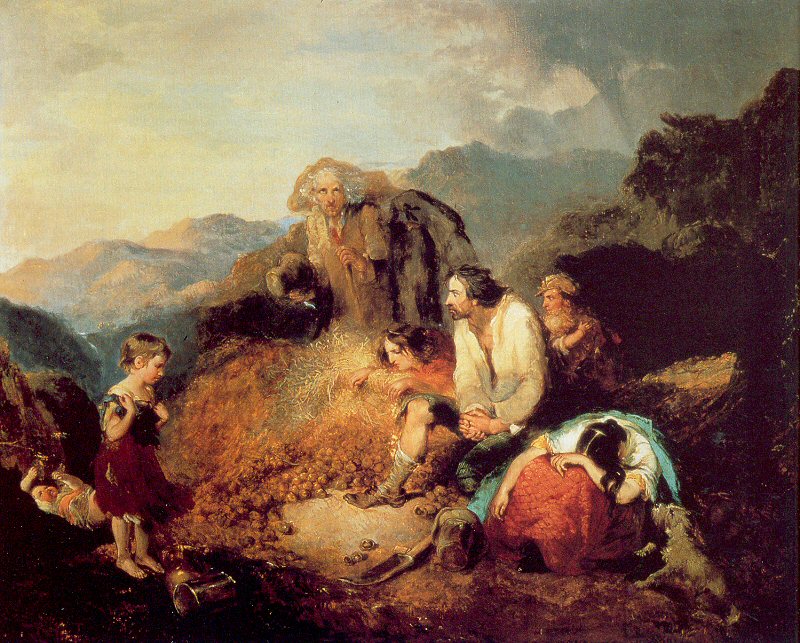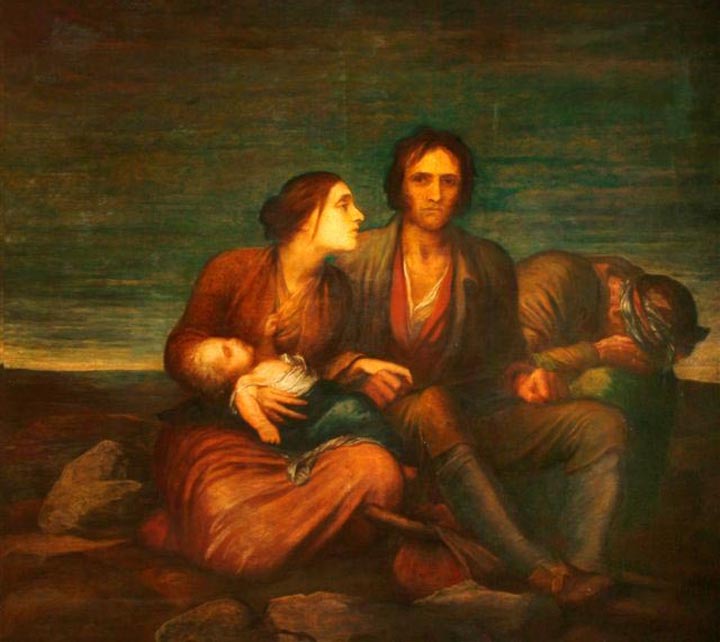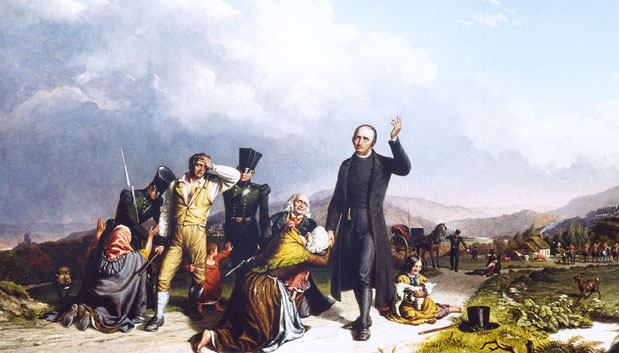There is more to famine than a lack of food. Hunger is always at the door, even in an era like our own. Do people starve because there are too many of us as Parson Malthus asserted? Or, is famine the companion of civilization? Do the hungry die of politics and not population outdistancing food supply? Or, in fact, do the hungry dies of politics? The Irish potato famine…
Paradoxically, throughout the famine, Ireland exported grain to England. Irish farmers ate potatoes; indeed they had to eat potatoes. The grain they produced they sold to pay their rents; if they did not sell their grain, their landlords would evict them from their farms; if they were evicted, they lost their livelihoods, their houses, and their potato fields, which, while worthless in 1845, might feed them in 1846. And so, while the Irish starved, the grain was shipped to England. As Charles Edward Trevelyan, head of the English treasury in the 1840′s, declared, ” Do not encourage the idea of prohibiting exports…perfect free trade is the right course.” So, the export based politics ( IMF, World Bank) of third world countries today is hardly a new phenomenon.

—Was the Potato Famine an ecological accident, as historians usually say? Like most famines, it had little to do with declines in food production as such. Adam Smith was right that “bad seasons” cause “dearth,” but “the violence of well-intentioned governments” can convert “dearth into famine.”
In fact, the most glaring cause of the famine was not a plant disease, but England’s long-running political hegemony over Ireland. The English conquered Ireland, several times, and took ownership of vast agricultural territory. Large chunks of land were given to Englishmen.
These landowners in turn hired farmers to manage their holdings. The managers then rented small plots to the local population in return for labor and cash crops. Competition for land resulted in high rents and smaller plots, thereby squeezing the Irish to subsistence and providing a large financial drain on the economy.
Land tenancy can be efficient, but the Irish had no rights to the land they worked or to any improvements they might make. Only in areas dominated by Protestants did tenant farmers have any rights over their capital improvements. —( painting Daniel MacDonald) click image for source…
The first samples of the new 1845 crop revealed that the crop failure of 1846 was destined to be even more severe than 1845. Treveelyan’s reaction was immediate. Government relief programs must be closed down, he said: “The only way to prevent the people from becoming habitually dependent on Government is to bring the operation to a close.”
Most of the Irish easily avoided becoming dependent upon the government. They pawned their clothes and bedding to buy food. They ate boikled cabbage leaves, roots, weeds, and nettles. Children were put in workhouses where, in Skibbereen at least, more than half of them died “at the rate of one hundred a week.”

—The political, economic and humanitarian failure of England’s response to the famine amounted to — no joke intended — a game of hot potato between the British government and Irish landowners over who was responsible for aiding the poor. The now archetypal tableau of Irish grain being loaded onto ships bound for England as Ireland’s starving masses watched speaks of the landowners’ indifference to anything but their own income. The refusal of the British government to act decisively to stem the crisis early on arose from its determination to make Ireland “independent” (if only there were a way to make those scare quotes extra ironic). Both sides were ignorant and shortsighted, confident in their stereotypical notion of the irresponsible, fanciful and lazy “Irish character” but oblivious to all the ways that rural subsistence economies cannot be expected to start functioning like England’s more developed agricultural one overnight.—painting: George Frederick Watts, 1850. click image for source…
A magistrate in Cork wrote to the duke of Wellington:
Being aware that I should have to witness scenes of frightful hunger, I provided myself with as much bread as five men could carry, and on reaching the spot I was surprised to find the wretched hamlet apparently deserted. I entered some of the hovels to ascertain the cause, and the scenes which presented themselves were such as no tongue or pen can convey the slightest idea of. In the first, six famished and ghastly skeletons, to all appearances dead, were huddled in a corner on some filthy straw, their sole covering what seemed a ragged horsecloth, their wretched legs hanging about, naked above the knees. I approached with horror, and found by a low moaning they were alive – they were in fever, four children, a woman and what had once been a man. It is impossible to go through the detail. Suffice it to say, that in a few minutes I was surrounded by at least 200 such phantoms, such frightful spectres as no words can describe, either from famine or from fever. Their demoniac yells are still ringing in my ears, and their horrible images are fixed upon my brain. My heart sickens at the recital, but I must go on.
In another case, decency would forbid what follows, but it must be told. My clothes were nearly torn off in my endeavour to escape from the throng of pestilence around, when my neckcloth was seized from behind by a grip which compelled me to turn, I found myself grasped by a woman with an infant just born in her arms and the remains of a filthy sack across her loins – the sole covering of herself and baby. The same morning the police opened a house on the adjoining lands, which was observed shut for many days, and two frozen corpses were found, lying upon the mud floor, half devoured by rats. Read More:http://www.historyhome.co.uk/peel/ireland/skibber.htm

—The oil painting newly hung in the Burns Irish Room was done by R. G. Kelly and dates to 1848-51. Alternately titled “A Tear and a Prayer for Erin” or “An Ejectment in Ireland,” the work depicts the eviction of poor Irish from the land during the Famine. It is on two-year loan from Chicago real-estate developer Anthony John Mourek, a benefactor who previously backed the library’s acquisition of Ni Dhomhnaill’s papers.
“One of the few paintings of the Famine done at the time, it even sparked controversy in the House of Commons, as it deal
The starving Irish were too weak from hunger, or too accustomed to subjection, to rise in violent revolt; but in Roscommon, some three hundred starving men staged a protest march, and were scattered by two troops of mounted dragoons. ( to be continued)…






 COMMENTS
COMMENTS